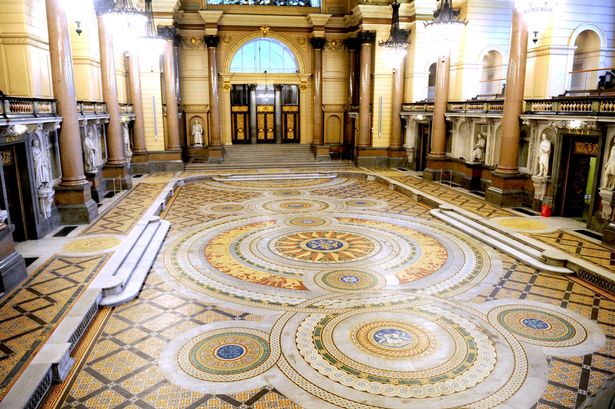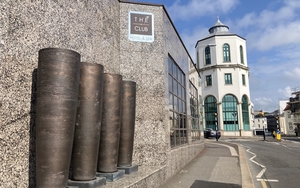IT'S one Britain’s heritage masterpieces, hidden from view for most of its life.
But when the ornate Minton floor at St George's Hall gets a rare public airing this Friday, the man guiding the way will be just as remarkable in the eyes of many visitors.
Steve Binns, official historian and tour guide to the city of Liverpool, has been blind since birth, yet the 62-year-old knows every inch of the grand Concert Hall as he leads people on tours.
Tens of thousands of hand-made tiles, in shades of buff, brown and blue, are normally covered over by wooden floorboards.
This weekend's unveiling, however, marks a “nine day wonder” - at least as far as eager sightseers go. The floor forms one of the greatest Victorian interiors in the world, according to critics, and thousands of people are expected to file past until August 16 .
“I see things differently,” said the cheerful guide, white stick in hand.
“Just because I am blind does not prevent me from appreciating our wonderful buildings and culture. I soak up the histories and events and I convey these as stories during my guided tours.
Binns lost his sight after he was given oxygen treatment following a premature and low-weight birth.
He added: “I don’t think I am missing out on anything as I have never known any different.”

Liverpool was the second city of the British Empire in 1840 when St George's Hall was constructed at a cost of £290,000 (estimated at almost £15 million in today's rates) and it looked every inch the part. The Albert Dock and warehouses, built in the same period, cost £700,000.
Binns said: “At the time the hall was being built Liverpool had a massive death rate as a result of deprivation and poverty. Yet the city decided to spend what in today’s money would amount of many millions of pounds on this grand hall.”
The lavish neo-classicial structure is up there among Prince Charles's favourite buildings in the world and Binns tells how Queen Victoria visited St George’s Hall in the 1860s and proclaimed it as worthy a design as the best of Ancient Greece.
The one time Poet Laureate of Britain, Sir John Betjeman, described the hall as a building he would die for.
For more than a century the hall, designed by 25-year-old Harvey Lonsdale Elmes and later CR Cockerell who was responsible for the interior, was home to the city’s Assizes Court where many criminals were dispatched to the hangman’s gallows. The court rooms remain a time warp, earning their keep by being hired out to film makers.

In the 1860s the main hall hosted a five day bazaar to raise money for the Confederate side in the American civil war. The event raised what in today’s money would amount to more than £2 million.
Added Binns: “St George’s Hall was a wow factor in the 1850s and remains so in the 21st century. Covering up its floor for most of its life ensures that will also survive for future generations.”
The last mystery…. why is it covered? Not surprisingly the clatter of dancing feet played a part. Soon after its opening a special all-wood cover was constructed when it was realised the grand balls being held were causing damage.
The floor remains open for viewing daily from Friday August 7 until August 16 (10am till 5pm, last admission 4pm), after which it goes back into hiding.












